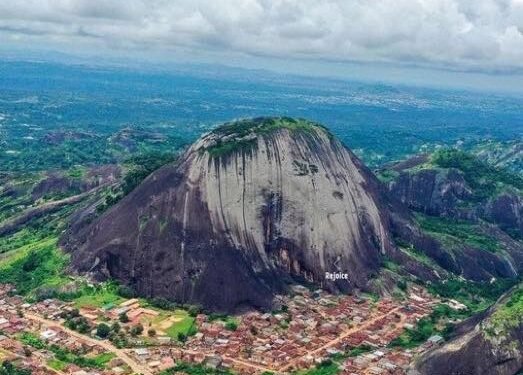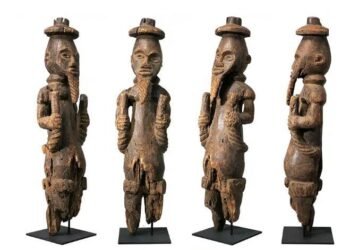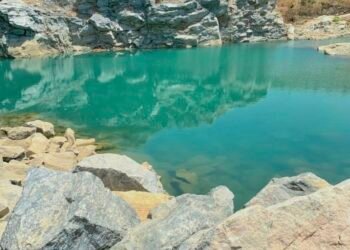Table of Contents
Idanre Hills Location
A tower above the green state of Ondo, the Idanre Hills are a magnificent wonder. They show us the creative effort of nature and the resilience of human beings.
Named Oke Idanre, the stunning vista is more than meets the eye as a geological wonder.
It is a living history book of spirit, culture, and history. For half a century, the hills hid an active community looking down on the world.
Today, they witness a unique heritage that intrigues historians, visitors, and pilgrims alike in equal proportion. Being on the UNESCO World Heritage Tentative List in 2007 is proof of its status as an international cultural landscape.
Idanre Hills Height
The sheer, dramatic presence of the hills is the result of immense geological patience. Processes spanning over 500 million years shaped their form. They are classic inselbergs; single rock hills that suddenly erupt from the general flat terrain and rise to the height of nearly 1,000 meters.
Its naturally fortified location of high plateaus, deep valleys, and enormous granite domes presented an ideal natural fortress. Its strength in defense, as well as its magnificent beauty, attracted ancient settlers who settled to create the Idanre community.
Read Also: Ogbunike Caves: A Hidden Natural Wonder in Anambra
Their legendary exclamation of wonder upon finding it, “Idan ree!”, meaning “It is miraculous!”, gave the hills their enduring name.

A Foundation Built on Legend
Idanre Foundation legend has Yoruba mythology as its source. Tradition recounts a tale of royal politics following Oduduwa’s death, the legendary Yoruba ancestor. A prince, traditionally reported to be Olofin Aremitan, fled the sacred city of Ile-Ife with loyal subjects.
He brought along the sacred Ade-Ide, the beaded crown of Oduduwa’s son. They arrived at this stunning cluster of hills following a lengthy, perilous journey through unfamiliar forests. Seeing its strategic and spiritual potential, they first sought shelter in caves.
Read Also: Olumo Rock’s History: A Fascinating Journey Through Time
Later, a legendary warrior and leader, Agboogun, guided the community to the summit to establish a permanent settlement known as ‘Ufe Oke’ or ‘Ife on the Hill’.
A Thriving Hilltop Civilization
For eight centuries, the summit of the Idanre Hills was occupied by a highly developed society, which represented human resourcefulness and adaptability at its best. This was a full-fledged kingdom, and not just a village, with a highly organized social structure and spectacular engineering.
The inhabitants constructed a royal palace with sophisticated defense systems. Strong houses and a formal legal framework marked their trail. Interestingly, they started a primary school back in 1896. Those remains show how dedicated they were to education.
By clever water-saving techniques, they were expert survivalists in periods of severe dryness. Though separated from the world below, they preserved a cultural identity deeply interwoven with wider Yoruba traditions. Their resilient and distinctive subculture thrived in the clouds, far from the world below.
Idanre Hills Footprint
The true magic of Idanre lies not just in its physical grandeur but also in its mystical soul. This is embodied by sites known as the “Nine Wonders.” More than simple landmarks, they are the bedrock of local identity, where myth and stone intertwine.
Read Also: Who Was Bilikisu Sugbon? Uncovering the History
One of the most captivating is Agboogun’s Footprint, a single indentation in the rock. Legend claims it mysteriously reshapes itself to match the foot of any visitor. This site was historically a powerful spiritual tool, used as a definitive test for witchcraft.
Then there are the Unreadable Signs, an enduring enigma carved into a rock face. These cryptic symbols have challenged all who have tried to interpret them. Their ancient message remains a tightly held secret from the past.

Each wonder adds a profound layer to the hills. These features turn the landscape into a meaningful story that continues to charm and inspire everyone who strolls along its paths.
The Omi Aopara, or “Thunder Water,” is a spring where warriors would go to drink before battle.
It was believed that if thunder echoed as they drank, it was an omen foretelling their death and sparing them from a doomed conflict.
Idanre Hills Location
The voluntary end to centuries of isolation marked a pivotal chapter for the Idanre community. As the 20th century dawned, new influences and practical challenges of mountain life prompted a monumental choice.
Driven by a desire for modernity and easier access to trade, the people made a collective decision to descend. Between 1923 and 1928, they left their ancestral home on the summit and established a new town on the plains below.
The physical descent was never a spiritual departure. The bond with Oke Idanre proved unbreakable. The hills remain the unwavering heart of their identity. It is a sacred landscape where kings are laid to rest and where annual festivals like Ogun and Orosun continually draw the community back up the ancient steps.
This perpetual pilgrimage powerfully honors their history, their deities, and the enduring spirit. It forever connects them to their origins.
How Many Steps Are In Idanre Hills?
Today, Idanre Hills receives a steady stream of travelers, each of whom takes a new pilgrimage to this fantastic destination. They arrive for various motives. Some come seeking a profound historical connection. Others are drawn by stunningly beautiful landscapes or travel for spiritual reflection.

Read Also: The Benin Kingdom: Facts About Benin Kingdom
The climax is the summit of the event. The grueling walk along the infamous 660-step stairway isn’t a workout of the body but also of the brain and the soul. It’s a metaphorical journey that brings us back to our past in a very tangible way.
The site’s capacity to provide such an evocative, layered experience has made it an iconic site. It tempts one to wander and leaves a lasting memory on anyone who crosses through it.
Preserving the Heritage
Keeping Idanre Hills the way it’s supposed to be is no walk in the park. The place has so much going for it, but honestly, it’s got some real problems knocking at the door; issues that could mess up its future if nobody steps up. A significant challenge is raising accessibility and appealability.
The present infrastructure needs careful development to accommodate a wider variety of visitors, including those who might find the ascent to be prohibitive. Sustainable management is the key.
The delicate ecosystem is prone to soil loss and depletion of native flora, whereas the old structures are at risk of physical wear and tear from touch and vibration. The effects of increased visitor numbers necessitate careful professional conservation. The overall mission is to achieve a critical balance: promoting tourism responsibly while benefiting the local community without damaging the site’s historical and spiritual nature.
This also involves provision for significant conservation demands to be met, such as stabilization of hilltop trails and ancient walls to prevent further erosion, implementation of physical visitor control interventions to reduce the frequency and mobility of groups, development of education signage to reduce damaging contact, rehabilitation and conservation of indigenous vegetation for ecosystem integrity preservation, and establishment of erosion controls to stabilize the land.
This priceless landmark’s existence depends on thoughtful, dedicated stewardship, and at its core, there has to be dedication to preserving not only the structures of a culture, but the living, beating heartbeat of life as it excites still today from those same old sources in the hills.
Your visit, advocacy, and stewardship can ensure the heritage of Idanre Hills continues through the centuries.









